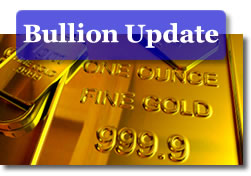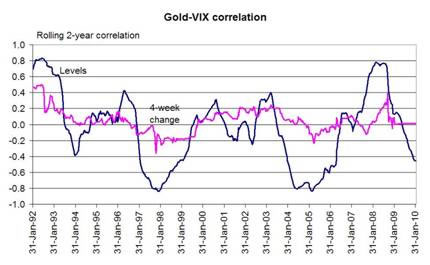 New York gold futures on Tuesday gained the most since early November as the dollar slid against other world currencies, attracting investment money into commodities. In major metals, gold gained 2.7 percent, silver soared 4.5 percent and platinum advanced 1.8 percent.
New York gold futures on Tuesday gained the most since early November as the dollar slid against other world currencies, attracting investment money into commodities. In major metals, gold gained 2.7 percent, silver soared 4.5 percent and platinum advanced 1.8 percent.
Crude futures rallied to above $77 a barrel. The near 4 percent jump was the best daily percent increase since late September.
US stocks gained as well following better-than-expected manufacturing figures in New York, and improved earnings reports.
New York precious metal figures follow:
-
Gold for April delivery surged $29.80 to $1,119.80 an ounce. The yellow metal ranged from $1,092.00 to $1,121.90.
-
Silver for March delivery soared 70.1 cents to close at $16.1480 an ounce. It ranged from $15.450 to $16.215.
- April platinum gained $26.60 to end at $1,537.70 an ounce. It ranged from $1,509.10 to $1,544.00.
In PM London bullion, the benchmark gold price was fixed earlier in the North American day to $1,115.25 an ounce, which was an increase of $17.00 from Monday. Silver rose 25 cents to $15.820 an ounce. Platinum was settled at $1,534.00 an ounce, rising $21.00.
Notable bullion quotes follow:
"Commodity prices are firming as the dollar weakens," Dennis Gartman, a Suffolk, Virginia-based economist and hedge- fund manager, said in his Gartman Letter today that was noted on Bloomberg. "The world has become disdainful of currencies generally, and is wrapping its collective arms around gold as the most readily available, reservable and believable currency."
"The metal is vulnerable to a euro-related pullback and now needs to clear resistance around $1,125 to cement more bullish sentiment," James Moore, analyst at TheBullionDesk.com, wrote in a note to clients that was cited on MarketWatch.
"The advance in gold came with a corresponding decline in the US dollar (recall that gold and the dollar have experienced a short-term de-couple over the past several trading sessions). Also aiding bullion’s gains were the declines in weak long spec positions that the market has witnessed in recent days," wrote Jon Nadler, senior analyst at Kitco Metals, Inc. "The majority of gold’s overnight gains can, however, be attributed to the rising tide of short positions being put into place against the euro." [Read Nadler’s full commentary.]
Gold, considered a hedge during times of high inflation and economic uncertainty, tends to follow oil and move opposite to the U.S. dollar. A rising greenback makes dollar-denominated commodities, like bullion, more expensive for holders of other world currencies.
Oil and gasoline prices
Crude oil prices rallied, "as the dollar fell against the euro, bolstering the appeal of commodities as an alternative investment," wrote Mark Shenk of Bloomberg.
"On the back of high commercial inventories of crude oil and oil products, weak refinery demand in the western world and expanding OPEC production, we continue to see downside risk," said Commerzbank analysts in a note cited on MarketWatch.
New York crude-oil for March delivery jumped $2.88, or 3.9 percent, to finish at $77.01 a barrel.
The national average for regular unleaded gasoline fell six-tenths of a cent to $2.610 a gallon, according to AAA fuel data. The current average is 3.4 cents lower than last week, 13.9 cents less than a month back, but 64.5 cents higher than the average from a year ago.
U.S. Stocks
U.S. stocks also rallied on the day "as better-than-expected quarterly results from Merck and Barclays reassured investors, and the weaker dollar boosted commodity prices and shares," writes Alexandra Twin of CNNMoney.com.
"Earnings are coming in pretty strong and that’s what moves markets in the end," John Carey, a Boston-based money manager at Pioneer Investment Management, which oversees more than $200 billion, was quoted on Bloomberg. "Manufacturing is increasing globally and there will be demand for raw materials, even in the U.S. we’re seeing an increase in manufacturing. People are positioning themselves to take advantage that."
The Dow Jones industrial average gained 169.67 points, or 1.68 percent, to 10,268.81. The S&P 500 Index advanced 19.36 points, or 1.80 percent, to 1,094.87. The Nasdaq Composite Index rose 30.66 points, or 1.40 percent, to 2,214.19.
Gold, Silver, and Metals: Prices and Commentary – February 16, 2010
by Jon Nadler, Kitco Metals Inc.
Good Morning,
Gold prices broke above the $1100 mark and rose to a two-week high as overnight trading got underway in Asia, giving rise to short-covering purchases that only accelerated once the $1106 resistance area was also taken out. The yellow metal reached a high at very near another resistance point –that of $1118.50 per ounce. Other commodities – mainly oil and copper-advanced as well, as speculators funneled money into the sector on currency weakness. That said, technical analysts see black gold as eventually falling back towards $73 soon, as it has been unable to pierce overhead resistance at the $76 level.
This time, the advance in gold came with a corresponding (about 0.5%) decline in the US dollar –which slipped to 80.10 on the trade-weighted index (recall that gold and the dollar have experienced a short-term de-couple over the past several trading sessions). Also aiding bullion’s gains were the declines in weak long spec positions that the market has witnessed in recent days.
The majority of gold’s overnight gains can, however, be attributed to the rising tide of short positions being put into place against the euro. The tables have turned, and short-sellers are now flogging the common currency with the same degree of gusto with which they battered the greenback in 2008 and 2009. At last check, the US dollar was trading at 1.365 against the euro – not as high as we have seen it in recent days, but still, a level which was previously hardly fathomed.
One of the intriguing aspects of the EU debt fiasco is the fact that Greece –for example- carries on with a budget deficit that amounts to less than 13% of GDP while it carries a 2% weight in the common economic zone’s overall GDP. France plus Spain, on the other hand, with deficits ranging from 8.3 to 11.2 percent of their GDP add up to practically 30% of the EU’s total GDP. And then, there is Portugal – its debt to GDP ratio is nearing 85% this year. In so many words, the jitters currently manifest in the Old World could not be better founded…
Nearly $8 billion in euro-short positions is manifest in the markets at this time. Little wonder then, that we can-this morning-talk of a new record gold price. In euro terms, that is. Gold touched 818.00 an ounce-its highest euro-denominated price on record. Market guru Dennis Gartman waxed poetic in his analysis this morning, declaring that: "The world has become disdainful of currencies generally, and is wrapping its collective arms around gold as the most readily available reserve(able) and believable currency.”
New York’s spot markets reopened after Monday’s hiatus to find the metals rising in concert this morning. Gold advanced $12.40 per ounce, to start the day at $1111.90 as against the aforementioned losses in the dollar and the jitters plaguing the euro. Silver climbed 19 cents on the open, starting the day off at $15.71 an ounce. Resistance in gold remains overhead, with the need to overcome $1118.50 and –more importantly- $1126.50 an ounce remaining a prerequisite for further advances towards the speculative targets of between $1160 and $1180. Indian demand has once again slowed following the overnight price spike, and Chinese demand related to the New Year’s is now over. Fresh buyers wanted.
Price support is currently seen extending from $1092 to the $1105 area. Physical demand, on the other hand, (especially as manifest in the gold ETFs, remains –in the words of GoldEssential.com analysts- "dull, with no apparent signs of an immediate pick-up visible. While there has been a small 0.41 tonne inflow on Monday, the year-to-date overall reading is still negative by nearly 24 metric tonnes."Markets will now focus on the German ZEW Economic sentiment gauge and U.K.’s CPI and RPI indices, while US housing starts data comes our way tomorrow. Later in the week, the focus will shift to key inflation data, including the U.S. producer and consumer prices index.
Platinum gained $16 to the $1529 level and palladium rose $8 to $427 the ounce. Rhodium was steady at $2350 per troy ounce. Recent market talk indicates that Indians are growing fond of platinum, even if the noble metal currently only accounts for about 2.5% of the local jewellery market. Market analysts have also proposed that global automakers and other users might warm up to loading up on palladium inventories should the metal find itself under the $400 level any time soon.
While the recurring dis-connects and re-connects between gold and various currencies continue to make short-term headlines, an interesting correlation of a different type has come to our attention; the one between gold and the VIX index (a.k.a. the FEAR gauge). The UK’s Investors Chronicle notes that:
"Since mid-January, stock markets have become noticeably more jittery; not only have prices fallen, but the VIX index – the so-called fear gauge – has risen almost 10 percentage points. If gold were a safe haven, it should have risen. In fact, it’s lost $50 an ounce."
The IC notes that while there is a positive correlation between the two, it is rather small, and it does extend over a long time period. Specifically: "[The correlation has] been 0.2 in weekly data since 1990. But 0.2 is low. It means there are many times when a high VIX is accompanied by low gold prices, not high ones. For example, when Lehman Brothers went bust, liquidity vanished. The VIX tripled between August and November 2008, and gold lost 15 per cent. This was the converse of what happened between 2003 and 2007, when easy monetary conditions kept the VIX low and contributed to a near-doubling of the gold price."
Here is what this odd-couple relationship looks like in visual terms:

The article thus opined that "if shares prices fall as the world’s central banks tighten monetary policy, gold might not benefit" or that "gold could suffer if shares fall on account of fears of a double-dip recession."
That said, the take-home lesson of the IC findings is that –regardless of what we might want to call gold: "safe-haven" (or not, as shown by its curious relationship to the VIX), the "ultimate currency" (or not, as the occasional mass stampedes into the dollar reveal), or just "plain-vanilla insurance" against the unpredictable world in which we live (the one label this particular writer chooses to go with), it has a valid place in one’s basket of assets. The idea is not to get carried away with false expectations, however. Thus, the IC’s Chris Dillow concludes that:
"None of this means gold has no place in a diversified portfolio. It does, as it has low correlations, on average, with gilts and equities. A low correlation, though, is a different thing from a strongly negative correlation."
Once again, a HAPPY YEAR OF THE TIGER to our Chinese audiences!

Jon Nadler
Senior Analyst
Kitco Metals Inc.
North America
Blog: http://www.kitco.com/ind/index.html#nadler
In bullion and numismatic coin news of the day, Bullion Exchange International Brings Silver and Gold, the United States Mint publishes 2010 Boy Scouts and Disabled Vet Coin Prices, and the Royal Canadian Mint issues Year of the Tiger in 2010 Gold and Silver Coins.










